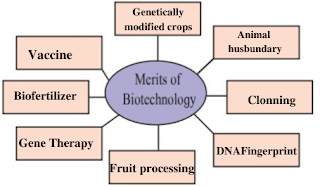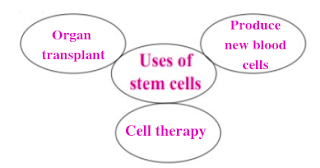Cell biology and Biotechnology class 10 Solutions Maharashtra Board
Important points to Remember about Cell biology and biotechnology :
- Cytology: Study of the structure, types and organelles of the cell as well as study of cell division is called as cell biology/cytology.
- Vaccine: Vaccine is the antigen containing material given to acquire either permanent or temporary immunity against a specific pathogen or disease.
- Cloning: Production of replica of any cell or organ or entire organism is called cloning.
- Green revolution: Various methods applied for harvesting maximum yield from minimum land are collectively called as green revolution.
- The techniques of bringing about improvements in living organisms by artificial genetic changes and hybridization for the welfare of human beings are together called biotechnology.
- Cells present in the entire body except those present in gonads i.e. testis and ovary are called somatic cells.
- A group of cells having the same origin, same structure and same function is called a tissue. Tissues perform different functions based on its type like contraction and relaxation of muscles, transportation of food and water in plants, protection and joining of different body parts etc.
- Myocardial infarction: In simple terms it is nothing else but heart attack. It results in stoppage of blood flow to the heart muscles. Alzheimer’s disease: A disease in which there is loss of memory and hampers other mental functions.
- Stem cells are used for generation of new skin for burn victims. It is a much faster process than the typically followed process of growing skin elsewhere on the body which can take weeks to grow.
- Endocrine system refers to secretion of hormones directly into blood which then has a specific effect on particular organs of the body in humans.
Maharashtra State Board Solutions for Science Part II Class 10 Chapter 8 Cell Biology and Biotechnology :
a. Methods like artificial insemination and embryo transplant are mainly used for —
b. — — — — is the revolutionary event in biotechnology after cloning.
c. The disease related with the synthesis of insulin is — — —.
d. Government of India has encouraged the — — — — for improving the productivity
by launching NKM-16
a. Methods like artificial insemination and embryo transplant are mainly used for animal husbundary
b. Stem cell technology is the revolutionary event in biotechnology after cloning.
c. The disease related with the synthesis of insulin is diabetes.
d. Government of India has encouraged the people for pisciculture for improving the productivity by launching NKM-16.
| a.Interferon | 1.Diabetes |
| b.Factor VIII | 2.Dwarfness |
| c. Somatostatin | 3.Viral infection |
| d. Interleukin | 4. Cancer |
| 5. Hemophilia |
| a.Interferon | 1.Viral infection |
| b.Factor VIII | 2.Hemophilia |
| c. Somatostatin | 3. Dwarfness |
| d. Interleukin | 4. Cancer |
statements after corrections.
a. Changes in genes of the cells are
brought about in non-genetic technique.
Answer: Changes in genes of the cells are brought about in genetic technique.
introduced into soyabean.
a. Biotechnology: Professional uses.
- Crop biotechnology: Biotechnology is used in agricultural field to improve yield and variety of the crops.
- Animal husbandry: Two main methods – artificial insemination and embryo transfer are used in animal husbandry. It helps to improve both, the quantity and quality of animal products.
- Human health: Diagnosis and treatment of the diseases are two important aspects of the human health management.
- Industrial Biotechnology (Products)/ White biotechnology: Various industrial chemicals can be produced through less expensive processes.
- Environment and Biotechnology: It has become possible to solve environment related various problems with the help of biotechnology.
- Food biotechnology: Food items like bread, cheese, wine, beer, yoghurt, vinegar are produced with the help of microorganisms. These food items are probably the oldest ones produced with the help of biotechnology.
- DNA fingerprinting: DNA sequence of each person is unique as that of the fingerprints. Due to this, identity of any person can be established with the help of its available DNA. This is called as DNA fingerprinting. It is mainly useful in forensic sciences.
b.Importance of medicinal plants.
Answer: Medicinal plants are those which have medicinal properties and provide temporary relief or permanent cure from ailments. Following are some of the important applications of medicinal plants:
- Medicinal plants like black pepper, cinnamon etc. help in healing wounds.
- Medicinal plants like herbs are used to purify blood.
- Herbs also help boost immunity of a person, thereby reducing the chances of contracting diseases.
- Medicinal plants like turmeric inhibit the growth of harmful microbes. Turmeric is added in Indian food for imparting taste and also because of its antibiotic properties.
- Some medicinal plants also act as antacids and helps reduce the acidity level in the human body
5. Answer the following questions in
your own words.
a. Which products produced through
biotechnology do you use in your daily
life?
Answer:
- The use of biotechnology has increased, where almost all the necessary items are obtained through biotechnology.
- Products like food grains are genetically modified crops which contain vitamins or any other nutrients at a much higher quantity than the naturally grown plants.
- Dairy products like cheese, yoghurt, probiotics etc. are produced using microbial biotechnology.
- Apart from food items, products like antibiotics, vaccines for several diseases that are now available are the products of biotechnology.
- Biofuels are also obtained through biotechnology which is useful in our daily life.
b. Which precautions will you take
during spraying of pesticides?
Answer: Pesticides are chemicals that are used to kill pest. They include insecticides, weedicides, herbicides etc. Care has to be taken while using pesticides because of its chemical nature.
- Only recommended amount of pesticide should be sprayed.
- Care should be taken that pesticide is not sprayed in the opposite direction to that of wind.
- Containers used for mixing or storing pesticide should not be used for domestic purposes.
- Animals or humans should not be allowed in the field immediately after spraying pesticide.
body are most valuable?
Answer:
- Human body is an amalgamation (combination) of different organs working together for the smooth functioning of the various life processes which are vital for life.
- Even though each organ has a unique and important part to play in the efficient working of a human body, organs like brain, heart, lungs, liver and kidneys are some of the vital organs of human body.
- Brain is the main CPU of the human body which controls all other vital life processes. The pituitary gland present in the brain controls the endocrine system of the body which in turn affects all other organs.
- Human heart is myogenic i.e. it works on its own with the help of cardiac muscles and pumps blood to the rest of the body.
- Lungs present along with heart in the thoracic cavity are involved in respiration which supplies oxygenated blood and removes carbon dioxide (CO2) from the body.
- Liver is one of the most important organs of the body because of its ability to carry out different functions including production of bile which is necessary for digestion process, destruction of old RBC’s, removal of toxic elements from the body etc. Liver has a very important role to play in the fetal stage, as it produces RBC’s.
- Human kidney is important as it carries out excretion and osmoregulation which helps maintain osmotic balance in the body and also eliminates harmful substances out of the body.
- Apart from the vital functions these organs carry out, these organs can also be donated to a needy thus helping in saving someone’s life.
- Organs like heart, eyes and liver can be donated after death (posthumous) of an individual, whereas some organs like kidney can be donated during the lifetime of an individual.Hence, some of the organs human body are most valuable.
d. Explain the importance of fruit-
processing in human life?
Answer:
- Fruit processing is one of the most rapidly growing industries in modern times. Products like chocolate, juices, jam, jelly etc. are made from fruits through fruit processing.
- Fruit processing helps in preservation of fruits, which can be consumed even during off seasons, when those fruits are not available in its natural form. Fruit processing methods range from cold storage to drying, salting, air tight packing, preparing murabba, evaporating, etc.
- There is a scope for increase in employment opportunities because of development of food processing industries.
- Revenue from export of food processing products like jams and jellies also increases. Also, as these are preserved products they have a longer shelf life.
Answer:
- Vaccine is the ‘antigen’ containing material given to acquire either permanent or temporary immunity against a specific pathogen or disease.
- Vaccination is a process by which vaccines are either injected or given orally to a person to develop immunity against a particular pathogen.Example: Polio virus is used against polio disease which is caused by poliovirus.
- From ages antigens were used in vaccines, where the disease causing pathogens were either completely or partially killed and then used in a vaccine.
- However, in these cases there were chances of the person not getting complete immunity from the vaccine and the antigen itself causing disease.
- Due to these reasons scientists made use of biotechnology to prepare artificial vaccines.
- For artificial vaccines, genes of disease causing pathogen were taken and antigenic preparation were made from it which was then used as a vaccine.
- This enabled efficient and safe vaccine production. Nowadays, completely or partially killed bacteria are not used as vaccines. Instead, proteins of the antigens in its pure form are used as vaccines.
- These protein vaccines develop immunity against a particular disease/pathogen in a person, and keep him/her disease free.
- These vaccines are safe and since they have high temperature withstanding capacity, they can survive for a longer duration. Example: Hepatitis vaccine.
6. Complete the following chart.
correlations.
a. Insulin : Diabetes :: Interleukin : — — —
Answer: Insulin : Diabetes :: Interleukin : Cancer
Anemia.
Hemophilia.
d. White revolution : Dairy :: Blue
9. Write a comparative note on usefulness
and harmfulness of biotechnologyAnswer:
- It has become possible to increase the per hectare yield irrespective of the limitations of crop-land area.
- Expenses on disease control have minimized since development of resistant varieties.
- Due to development of fast fruit setting varieties, yield per annum has been increased.
- Development of stress resistant varieties which can withstand variable temperature, water-stress, changing fertility of soil, etc. has become possible.
- Different antibiotics and vaccines have been prepared by making use of biotechnology.
- GM (Genetically Modified) crops though are loaded with nutrients; there is always a danger of containing allergens in it which can prove to be fatal. Therefore, products containing GM derived ingredients need to be mentioned in the labelling.
- Pesticide resistant crops do give us protection but it creates a much bigger threat of developing disease resistant bacteria which will not be affected by any pesticides in the near future.
- New genes are being introduced in animals which were not previously found in those animals. Thus, it creates an ethical issue about the brutality an animal has to undergo through biotechnology.
- Due to these reasons, biotechnology is always a topic of debate on social, ethical and cultural aspects.

